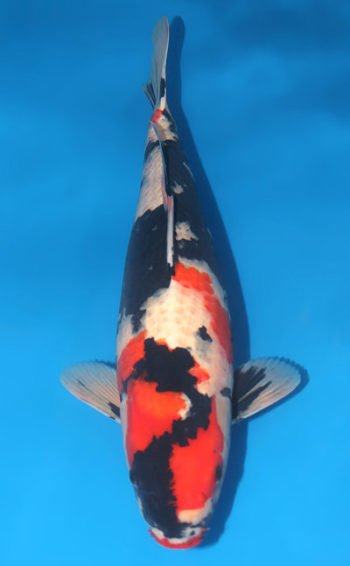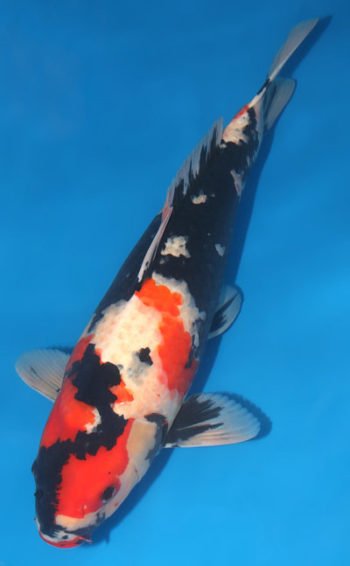Showa Koi Female Fish
See all of our high-quality koi fish for sale & butterfly koi fish for sale. We offer the very best selection of koi for sale in the industry. Put that alongside of our incredible 14-Day Live Arrival Guarantee, and the ability to choose your own delivery date and you have an unbeatable value.
14-DAY WORRY-FREE GUARANTEE: We offer an industry-leading 14-Day Worry-Free Guarantee to ensure that you can shop with peace of mind, knowing that you will always be covered.
Breeder(s): Arowana Paradise Farm
Sex: Female
Size: 22.44 inch
Variety: Showa
$550.00 Original price was: $550.00.$450.00Current price is: $450.00.
Description
Showa Koi Female Fish For Sale
Showa Koi Female Fish, Koi with a red head patch are called “Tancho.” Most common are “Tancho Kohaku (all-white Koi with Tancho),” “Tancho Sanshoku (white Koi with Sumi similar to Shiro Bekko, and with Tancho),” and “Tancho Showa (Showa Sanshoku without red markings except for Tancho),” etc. However, “Tancho Goshiki (Koi of five colors with Tancho),” and “Tancho Hariwake” are rare.
Tancho do not form a single, independent kind of Nishikigoi; they all can be bred from Kohaku, Taisho Sankshoku or Showa Sanshoku. Their red patch happen to show up only in the head region. Tancho, therefore, cannot be produced in bulk even if you so wish.
The essential point for appreciation is the red patch in the head region, of course. The red head patch sitting right at the center of the head region is the best. The white skin is also important as it is the milky white color that sets the red head patch off to advantage. The Sumi of Tancho Sanshoku and Tancho Showa are the same as Bekko and Shiro Utsuri respectively.
Tancho are gorgeous snowy white koi with a large Hi marking on their heads. The position of the Hi marking is very important and should be well proportioned on just the head. The round Hi needs to cover as much area as possibly between its eye and nose. But without covering the eye or the nose. The edge must be sharp and the coloration must be deep red. The Hi should not spread to the shoulders or back and the body and the white body should be free of any imperfections.
Tancho sanke koi For Sale Online
Taisho Sanke, or Sanke for short, are koi with a solid white base overlaid by patterns of both red and black. It is commonly said that a high quality Sanke pattern begins with a great Kohaku pattern, to which the black is a welcome complement. Variations of Sanke include Doitsu Sanke, Maruten Sanke, Tancho Sanke, and Gin Rin Sanke.
This Sanke Koi For Sale was selected on our recent trip to Israel, we pride ourselves with over 30 years’ experience selecting koi from both Japan and Israel. All our Koi For Sale are settled into our extensive facilities where they are quarantined and given a complete health check.
Koi Care Guide – Six things to know about your koi
- Experience Level: Intermediate
- Size: Koi grow up to 36 inches (91 cm) long
- Lifespan: They can live for more than 50 years and thrive in a wide range of water temperatures
- Temperament: They are generally peaceful but may pick on slower fish
- Origin: They’re a type of carp native to Japan
- Did You Know: Koi can learn to recognize and take food from their pet parents
How do I set up my koi’s aquarium?
- Koi grow quickly and get very large. Keep mature koi in an outdoor pond of at least 3 feet deep, with at least 50 gallons of water per fish.
- Young koi can be kept indoors in an aquarium of at least 29 gallons.
- Put the aquarium in a quiet area out of direct sunlight and drafts.
- Cover the aquarium with a hood to reduce evaporation and splashing and to keep fish from leaping out.
- To transfer new koi to the aquarium, float them in the water inside their bag for about 10 minutes so they can acclimate to the new water temperature.
- If you’re introducing koi to an existing school in an aquarium or pond, quarantine the new fish in a separate body of water for 2 to 4 weeks to be sure they are healthy.
- On moving day, use a net to transfer the koi so old water doesn’t mingle with new water.
- Whether they live indoors or outdoors, add no more than 3 new koi at a time.
Heat & light
Outdoor koi are hardy and will hibernate under ice in winter as long as their pond is deep enough to not freeze completely. (They won’t survive in solid ice.)
Your koi’s pond should be partially shaded.
Indoor koi prefer water between 65 and 75 degrees Fahrenheit.
Install a light inside an indoor aquarium to illuminate it for 8 to 12 hours a day.
Water temperature
Koi are pretty temperature-resistant— they can even hibernate under ice in winter. Just be sure your pond is at least three feet deep— otherwise, it could freeze solid, and koi aren’t that tough. When they live indoors, koi prefer cool water—between 65 and 75 degrees F (18 to 24 C).
How do I keep my koi healthy?
If your outdoor koi don’t seem to be eating in the winter, don’t worry; it’s normal for them to stop eating at temperatures below 40 F. Be sure to contact a veterinarian if you notice any of these symptoms:
- Unusual swimming pattern
- Thinness or decreased appetite
- Abdominal swelling
- Inflamed or discolored skin or fins
- Fins clamped to sides of body
- Scraping body on rocks (flashing)
types of koi fish, koi fish, koi fish price, koi fish pond, koi fish meaning, koi fish for sale, koi fish drawing, koi fish care, koi fish for sale online, butterfly koi for sale, koi fish for sale near me, big koi for sale, buy koi fish cheap, koi fry for sale usa, types of koi fish, koi fish for sale, High Quality Koi, Coy fish, coe fish, tancho showa koi, tancho sanke koi for sale, tancho koi, tancho sanke koi meaning, utsuri koi, goshiki koi, tancho koi betta, doitsu koi





Reviews
There are no reviews yet.